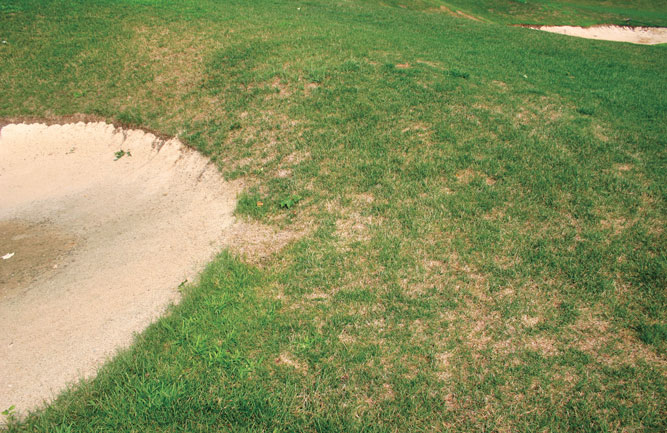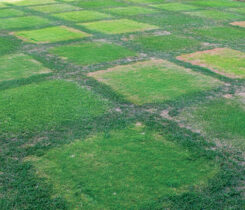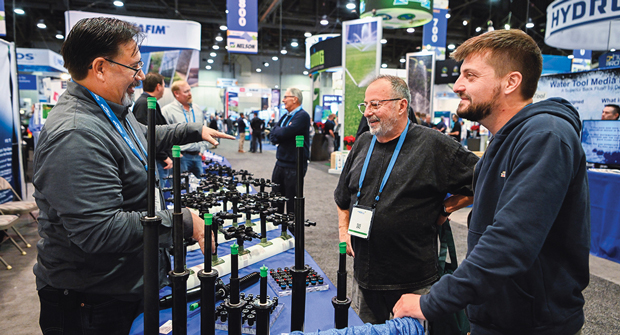Turf Pest of the Month: Don’t be fooled by billbug damage
Let’s say you’re a superintendent in the Southeast. Your course has bermudagrass roughs and fairways. You notice large patches of dead turf about 2 or 3 feet in diameter. It’s spring dead spot, right?
Not so fast, says David Shetlar, Ph.D., entomology professor emeritus with Ohio State University.
“Billbugs have always been mistaken for drought stress or disease,” he says. “Don’t make an assumption that you’re dealing with a disease or you’re dealing with a poor irrigation system or a drought issue or something without looking first. Billbugs will take advantage of those situations.”
Hunting billbugs are particularly challenging as adults emerge in June to join the overwintered adults and have a long life cycle. If a superintendent applies an insecticide in April and May, it’s possible to miss some of the hunting billbug larvae that will hatch in August and September. When September rolls around, the hunting billbug population ranges from nearly mature adults to larvae. The larvae will overwinter and continue to feed.
In the case of the superintendent with the supposed case of spring dead spot? Shetlar says superintendents need to examine the turf by raking through the blades and stolons.

This superintendent assumed this damaged bunker edge was from drought conditions, but upon closer examination, the damage was the result of bluegrass billbug larvae. (Photo: David Sheltar, Ph.D.)
“There will be little bits and pieces of the stolons that come up,” he says. “It will be dead grass with the dead stolons. If we start digging around in that area that had the little bits and pieces, we will come up with hunting billbug larvae.”
Shetlar says insecticides with clothianidin and bifenthrin work well for hunting billbugs and an application in the fall would protect courses in the Southeast in the winter.
“That will give you enough residual that it will kill any adults emerging from pupae that might be there, but it’s also active enough to kill even larger larvae,” he says. “So, if there are larger billbug larvae, small billbug larvae and even emerging adults, that one application in September should zero that out so that you don’t see any damage the next spring.”
Superintendents with cool-season turfgrass should also keep an eye out for hunting billbugs. Shetlar says Doug Richmond, Ph.D., professor of entomology at Purdue University, found hunting billbugs in Indiana.
Cool-season foe
Superintendents with cool-season turf typically see bluegrass billbug damage. As the pest’s name implies, it enjoys feeding on Kentucky bluegrass. Shetlar says many superintendents may mistake bluegrass billbug damage for drought. Shetlar says on occasion he’ll notice a dead spot on a bunker slope when he visits a superintendent. When he asks the superintendent about the patch of turf, the superintendent often suspects it’s a drought issue.
“When I would go over and do the tug test in those areas, I’d say, ‘See all these stems are hollowed out and they’ve got fresh pellets in there?’” he says. “What you’re seeing is the billbug damage on this slope and because of lack of irrigation, it’s showing up.”
Shetlar says superintendents should train crews to scout dead patches or yellowing of turf. A superintendent could mark a square meter of turf and use a detergent solution to flush out any pests to stay ahead of any issues. He recommends superintendents apply insecticides with active ingredients imidacloprid, clothianidin and bifenthrin in the last few weeks of April or early May. It’s also possible to grow through a bluegrass billbug issue.
“Where I see most of the damage on golf courses is usually in the areas that they don’t like to irrigate on a regular basis,” he says. “Damage shows up in those areas because the turf isn’t healthy. It’s stressed from not being irrigated. The tillers aren’t able to establish a root system, and they’ll die.”












